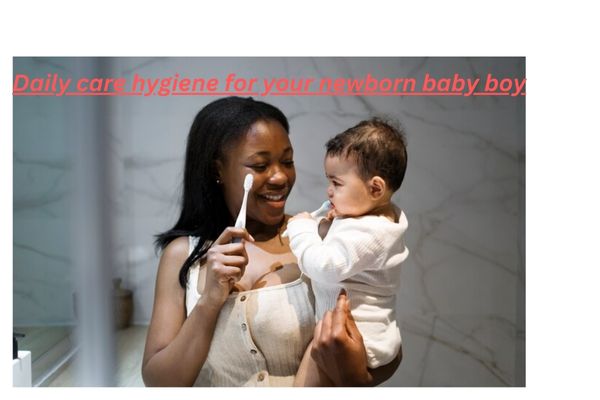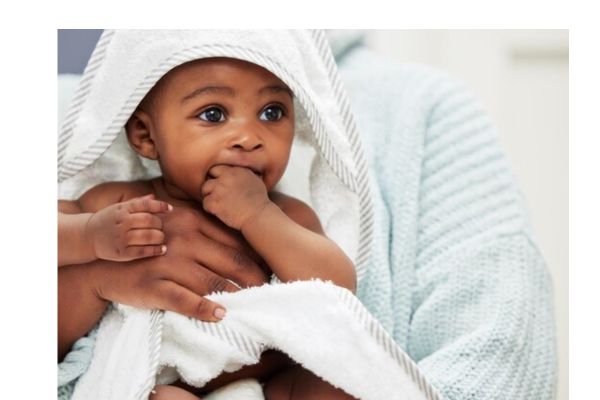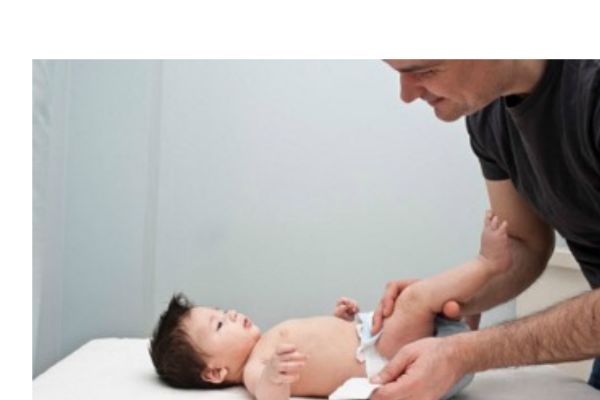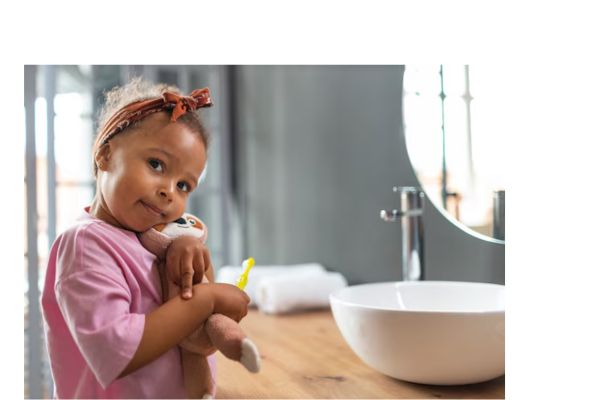
Daily Care Hygiene for Your Newborn Baby Boy
It’s an exciting time to welcome a newborn boy into your family, but there are a lot of duties involved, especially when it comes to his hygiene. Maintaining good hygiene is crucial for your baby’s health and wellbeing since it keeps him from becoming sick and keeps him content and at ease. This article will walk you through daily care hygiene for your newborn baby boy, from bathing and changing diapers to making extra allowances for his particular requirements.

Importance of Proper Hygiene for Newborns
Because of their sensitive and delicate skin, newborns need to be treated with extreme caution and loving care. Good hygiene habits are beneficial in a number of ways:
Preventing illnesses: Because their immune systems are still developing, newborns are more vulnerable to illnesses. Frequent cleaning can aid in the prevention of common illnesses such skin irritations, nappy rash and umbilical cord infections.
Comfort and well-being: A happy infant is usually one that is clean. Keeping your infant dry and tidy will keep him comfortable, lessen fussiness, and improve his sleep.
Bonding and Routine: Having daily hygiene rituals with your kid is a great way to strengthen your bond. Providing security and trust to your infant can be fostered through routine care tasks including as bathing and nappy changing.
Specific Considerations for Baby Boys
1. Genital Care
Maintaining your newborn baby boy’s health and avoiding infections requires proper genital care. Whether he is circumcised or not, this is particularly crucial because both require particular hygiene and comfort measures.
Cleaning During Diaper Changes
Regardless of whether your baby boy is circumcised or uncircumcised, it’s important to clean his genital area thoroughly during each diaper change. Here are some general steps to follow:
- Gather Supplies: Before you begin, have all your supplies ready, including clean diapers, wipes, warm water, a soft cloth, and any diaper cream you may use.
- Wipe Gently: Use baby wipes or a cloth dampened with warm water to gently clean the genital area. Always wipe from front to back to prevent spreading bacteria from the anus to the genital area.
- Dry Thoroughly: Make sure the area is completely dry before putting on a fresh diaper to prevent diaper rash and bacterial growth.
Care for Circumcised Boys
If your baby boy has been circumcised, special care is needed until the circumcision site heals, usually within 7 to 10 days:
- Keep It Clean: Gently clean the area with warm water and a soft cloth. Avoid using soap or baby wipes that contain alcohol or fragrance, as these can irritate the healing skin.
- Apply Petroleum Jelly: Apply a small amount of petroleum jelly to the tip of the penis and the inside of the diaper to prevent the area from sticking to the diaper, which can cause discomfort and delay healing.
- Monitor for Healing: Look for signs that the circumcision is healing properly, such as a yellowish film forming over the tip of the penis. This is normal. However, watch for signs of infection, such as excessive redness, swelling, or pus.
care for an uncircumcised baby boy
- Do Not Force Retraction: Do not attempt to pull back the foreskin. In newborns and young infants, the foreskin is typically not retractable and forcing it can cause pain and damage.
- Clean the Outside: Clean the outside of the foreskin gently with warm water and a soft cloth. There’s no need to use soap under the foreskin.
- Natural Retraction: Over time, the foreskin will naturally begin to retract. This can happen gradually over several years. Once it retracts on its own, teach your child to clean under the foreskin regularly during baths.

Signs of Infection
Regardless of circumcision status, it is crucial to monitor for any signs of infection in the genital area:
- Redness and Swelling: While some redness and swelling are normal, particularly after circumcision, excessive redness, and swelling can indicate an infection.
- Discharge: Pus or any unusual discharge from the penis requires medical attention.
- Fever and Irritability: If your baby develops a fever or seems unusually irritable, it could be a sign of an infection.
Umbilical Cord Care
Throughout the first several weeks of your newborn’s life, the umbilical cord stump is a tiny but crucial place that needs to be examined carefully. It must be properly cared for to avoid infections and guarantee that it heals until it falls off on its own. Here’s a comprehensive guide to caring for the stump left by your newborn boy’s umbilical chord.
Importance of Umbilical Cord Care
The portion of the cord that connected your unborn child to the placenta during pregnancy is known as the umbilical cord stump. The cord is clamped and severed after delivery, leaving a stump that usually dries out and comes off in a week or so. Keeping the area dry and clean aids in the healing process and helps avoid infections.
Steps for Umbilical Cord Care
- Keep It Dry
- Air Exposure: Expose the cord stump to air as much as possible to help it dry out. Avoid covering it with the diaper; fold the front of the diaper down to leave the stump exposed.
- Sponge Baths: Until the stump falls off, give your baby sponge baths instead of full baths. Use a damp cloth to gently clean the rest of the body while keeping the stump dry.
- Cleanliness
- Avoid Submersion: Do not submerge the stump in water. This can delay drying and increase the risk of infection.
- Gentle Cleaning: If the stump gets dirty, clean it gently with a cotton swab or cloth dipped in clean water. Do not use alcohol wipes unless advised by your pediatrician.
- Diaper Care
- Fold Diapers: Fold the top of the diaper down below the stump to avoid irritation and allow air to circulate around the area.
- Check for Wetness: Keep the area dry by checking frequently for any signs of wetness from urine or stool.
- Natural Healing
- Avoid Pulling: Let the stump fall off on its own. Do not attempt to pull or force it off, even if it looks like it’s hanging by a thread.
- Monitor Progress: As the stump dries out, it may change color from yellowish-green to brown or black. This is normal and indicates it is drying and healing.
Signs of Infection
Monitoring the umbilical cord stump for signs of infection is crucial. Contact your pediatrician if you notice any of the following symptoms:
- Redness and Swelling: Significant redness or swelling around the base of the stump can indicate an infection.
- Foul Odor: A foul-smelling discharge from the stump is a sign of infection and requires immediate medical attention.
- Pus: Any discharge that looks like pus is a cause for concern.
- Fever: If your baby develops a fever or seems unusually irritable, it could be related to an infection in the cord stump area.
Diaper Changes
Regular diaper changes are a critical part of your newborn baby boy’s hygiene routine. Proper cleaning of the diaper area helps prevent diaper rash, infections, and other skin issues, ensuring your baby remains comfortable and healthy
Newborn Diaper Change Frequency: Usually, newborns require a diaper change every two to three hours. You should plan on changing 8 to 12 diapers every day.
Indications of moisture: When the nappy becomes soiled or moist, change it right away. A wetness indication that changes colour in many diapers lets you know when it’s time for a change.
Preparing for a Diaper Change
- Gather Supplies: Have all necessary supplies within reach before you begin. This includes:
- Clean diapers
- Baby wipes or a bowl of warm water and soft cloths/cotton pads
- Diaper cream or ointment (optional)
- Changing pad or clean surface
- Clean clothes (in case of leaks or spills)
- Ensure Clean Hands: Wash your hands thoroughly before and after each diaper change to prevent the spread of germs.
2. Bathing Your Newborn
Babies don’t require showers every day. In actuality, giving your kid too many baths might cause their sensitive skin to become dry. Two to three weekly baths for your newborn are normally advised. When giving your infant a bath isn’t necessary, you can use a gentle washcloth to wipe their hands, face, neck and diaper area.
Best Time of Day for Bathing
Pick a time of day when your infant is content and awake. Bathing in the evening has been found by many parents to be beneficial in calming their infant and establishing a bedtime routine. The ideal timing, however, may change based on your baby’s routine and temperament. Make sure the moment is when you can give your kid your undivided attention without feeling rushed.
Supplies Required
Ensure that you have all the things you’ll need within easy reach before you begin the bath. This makes taking a bath easy and secure.
Baby Bathtub: A clean sink or a tiny plastic tub intended for babies are good options.
Mild Baby Soap: Look for a soap that is mild, fragrance-free, and tear-free.
Soft Washcloths: When washing and drying, use a clean, soft cloth.
Rinse Cup: To aid in the removal of soap residue, use a rinse cup or a tiny plastic cup.
Towels: After a bath, your baby will stay warm and comfortable with soft, hooded towels.
Clean Clothes and Diaper: After taking a bath, have clean clothes and a fresh diaper ready to put on.
Step-by-Step Bathing Process
Preparing the Bath Area
Warm Room: Make sure the space is sufficiently heated to keep your infant from being chilled. A temperature of about 75°F (24°C) is what you want.
Safe Setup: Position the infant bathtub onto a level, stable surface. Make sure everything you need is easily accessible so you don’t have to leave your infant alone.
Fill the Tub: Add a few inches of warm water to the infant bathtub. Make sure the water is comfortably warm—not hot—by testing its temperature with your wrist or elbow. The optimal temperature is approximately 38°C, or 100°F.
Maintaining the Infant’s Comfort and Safety
Gently undress your baby: making sure to keep their diaper on until you’re ready to put them in the tub to prevent mishaps.
Support the Baby: As you gently lower your infant into the water, hold their head and neck in one hand and their bottom with the other. For your baby’s safety, always have at least one hand on them.
Minimal Submersion: Don’t submerge your infant below the neck and head. While maintaining their body submerged in the water, you can use your arm to support their head and back.
Cleaning Each Part of the Body
- Face and Ears: Start by gently washing your baby’s face with a clean, damp washcloth. Be careful around the eyes and avoid getting soap in them. Clean the outer parts of the ears, but do not insert anything into the ear canal.
- Hair and Scalp: If your baby has hair, use a small amount of mild baby shampoo. Support your baby’s head and gently massage the shampoo into their scalp. Rinse carefully with a cup of clean, warm water, shielding their eyes with your hand.
- Body: Use a mild baby soap and a soft washcloth to wash your baby’s body. Pay attention to the neck folds, underarms, and diaper area, as these spots can collect sweat and dirt. Lift each limb gently to wash underneath.
- Diaper Area: Clean the diaper area thoroughly, especially if your baby had a bowel movement. For baby boys, ensure you clean around the genitals carefully. If your baby is uncircumcised, do not pull back the foreskin; clean only the outside.
Post-Bath Care
- Lift Out Safely: Once the bath is complete, lift your baby out of the water, supporting their head and neck. Be cautious as babies can be slippery when wet.
- Drying: Immediately wrap your baby in a soft, hooded towel to keep them warm. Gently pat their skin dry, paying extra attention to skin folds and the diaper area to prevent moisture from causing irritation.
- Moisturizing: If your baby’s skin is dry, apply a gentle, fragrance-free baby lotion. This step is optional and depends on your baby’s skin condition.
- Dressing: Put a clean diaper and fresh clothes on your baby. Ensure they are warm and comfortable.

4. Nail and Hair Care
Newborns’ nails grow quickly and can be quite sharp, so it’s important to keep them trimmed to prevent your baby from scratching themselves.
When to Trim: Although it might vary, baby nails usually need to be cut once a week. Because of their quick growth, some babies may require nail trims more frequently—even every few days.
Ideal Time to Trim: Your baby’s nails will grow back more easily after a bath or while they are asleep and peaceful. This can simplify the procedure and lessen the possibility of discomfort or harm.
Tools Needed for Safe Trimming
Baby Nail Clippers or Scissors: Use scissors or clippers made especially for small children. These smaller, rounded-tipped tools are designed to properly accommodate tiny nails.
Emery Board: If your nails are really soft and don’t require clipping, you can use a soft emery board or baby nail file to smooth the edges after trimming. Ways to Cut Your Baby’s Nails
Set Up the Space: Make sure your kid and you are seated in a comfortable area with adequate lighting. Make sure every tool is at arm’s length.
Edges: Gently smooth any rough edges using an emery board. This lessens the likelihood that your child may scratch themselves.
Examine for Cuts: If you happen to score yourself on the skin, wash the affected area with warm water and dab on some antiseptic. Apply little pressure with a delicate cloth until the bleeding stops.
Hair Washing and Care
Frequency of Hair Washing
Newborns do not need frequent hair washing. Washing their hair two to three times a week is usually sufficient unless they have cradle cap or other scalp conditions that require more attention. Daily washing can dry out their delicate scalp and hair.
Using Baby Shampoo
When washing your baby’s hair, it’s important to use products that are gentle on their sensitive skin and scalp.
- Choose the Right Shampoo: Select a mild, tear-free baby shampoo. Avoid shampoos with strong fragrances, dyes, or harsh chemicals that can irritate your baby’s skin.
- Prepare for Hair Washing: Gather all supplies, including the baby shampoo, a cup for rinsing, and a soft washcloth or sponge.
- Position Your Baby: During bath time, support your baby’s head and neck. You can wash their hair while they are in the baby bathtub or cradling their head over the sink.
- Wet the Hair: Use a cup to gently pour warm water over your baby’s head, making sure the water flows from the forehead back to avoid getting water in their eyes.
- Apply Shampoo: Pour a small amount of baby shampoo onto your hand or directly onto your baby’s scalp. Gently massage the scalp with your fingertips to create a lather. Avoid scrubbing too hard.
- Rinse Thoroughly: Rinse the shampoo out thoroughly with warm water, again ensuring the water flows away from the face. Make sure no shampoo residue remains, as it can cause irritation.
- Dry the Hair: Gently pat your baby’s hair and scalp dry with a soft towel. Avoid rubbing, which can cause hair to tangle or skin to become irritated.
Conclusion
For your newborn boy’s comfort, health, and general well-being, it is imperative that you provide him the daily attention and cleanliness he needs. Diaper rash, skin irritations, and infections can be avoided by adhering to a regular regimen that includes gentle bathing, correct diapering, skin care, and umbilical cord care. Use gentle, baby-safe products at all times, and pay special attention to your baby’s demands and reactions. Consulting your paediatrician on a regular basis might offer tailored advice and comfort. You may create a caring environment that promotes your baby’s healthy growth and development throughout these priceless early months by providing them with loving and attentive care.